The United Nations counts international migrants as people of any age who live outside their country (or in some cases, territory) of birth – regardless of their motives for migrating, their length of residence or their legal status.
In addition to naturalized citizens and permanent residents, the UN’s international migrant numbers include asylum-seekers and refugees, as well as people without official residence documents. The UN also includes some people who live in a country temporarily – like some students and guest workers – but it does not include short-term visitors like tourists, nor does it typically include military forces deployed abroad.
For brevity, this report refers to international migrants simply as migrants. Occasionally, we use the term immigrants to differentiate migrants living in a destination country from emigrants who have left an origin country. Every person who is living outside of his or her country of birth is all three – a migrant, an immigrant and an emigrant.
The analysis in this report focuses on existing stocks of international migrants – all people who now live outside their birth country, no matter when they left. We do not estimate migration flows – how many people move across borders in any single year.
Spotlight on Europe
International migrants in Europe most commonly come from other European countries: 53% were born elsewhere in Europe, as of 2020. The rest were mostly born in the Asia-Pacific or Middle East North-Africa regions.
In this report, Europe comprises 49 countries and territories, including 26 of the European Union’s 27 members.27 Moving within the EU is relatively easy for EU nationals, which helps explain the large number of migrants who were born within the region.
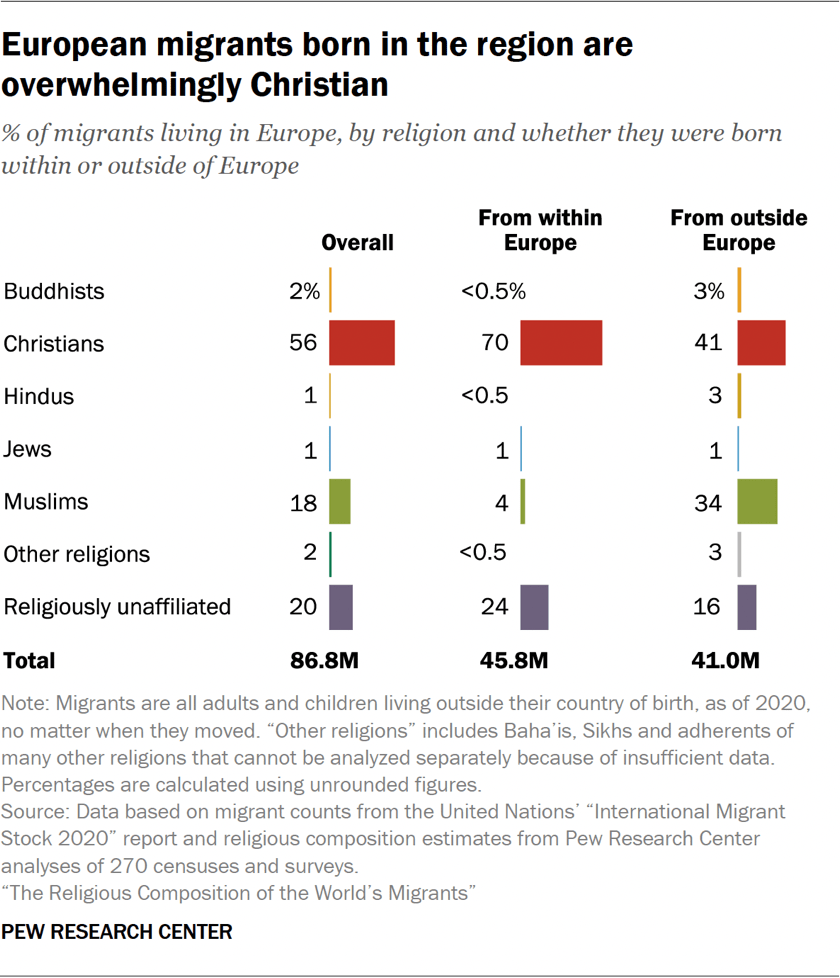
In recent decades, some politicians and authors have raised concern about the degree to which European culture is being changed by an influx of migrants from outside the region. The public debate has often focused on Muslims, including an influx of asylum-seekers from Syria.
Most migrants living in Europe are Christian, along with sizable minorities of religiously unaffiliated people and Muslims.
However, migrants are more likely than the general population to be Muslim (18% of migrants in Europe vs. 7% of Europe’s overall population), less likely to be Christian (56% vs. 72%) and equally likely to be religiously unaffiliated (20% vs. 20%).
Buddhists (making up 2% of migrants in Europe vs. 0.2% of Europe’s total population), Hindus (1% vs. 0.2%) and Jews (1% vs. 0.2%) make up small shares both of migrants and of the general population in Europe.
Between 1990 and 2020, the share of all migrants living in Europe who are Muslim has grown from 16% to 18%, largely due to increasing arrivals from Morocco, Syria and Turkey. On the other hand, the share of religiously unaffiliated migrants decreased, and the share of Christians was stable, as many people who were part of earlier waves of migration from Russia moved elsewhere or died.
Among migrants living in Europe, the religious composition of those born within the region varies from those born outside the region.
Migrants from within the European region are far more likely than those from outside the region to be Christian (70% vs. 41%), slightly more likely to be religiously unaffiliated (24% vs. 16%) and far less likely to be Muslim (4% vs. 34%).
Christian migrants in Europe most often come from Russia, Ukraine and Poland. Many religiously unaffiliated migrants were born in Russia, Ukraine and Kazakhstan. Many Muslim migrants were born in Turkey, Morocco, Syria and Algeria. Buddhists and Hindus almost exclusively come from countries outside of Europe. Jews are about equally likely to have moved from within or outside of Europe.
We can’t isolate the religious composition of those who migrated in a particular period. However, we know that war, famine and political circumstances can cause big migration shocks. War in Syria sent many Muslims trekking to Europe, and Russia’s 2014 invasion of Ukraine led many Christians to seek refuge in other European countries.
Many countries in Europe have low fertility rates and migration has helped stave off population decline. The total population of the region grew by 23 million between 1990 and 2020. During this period, the population of migrants from outside Europe grew by 21 million.
Seven European countries’ populations would have shrunk without new migrants from within or outside the region. For example, Germany’s total population grew by 4.1 million over this 30-year period, while its migrant population grew by 9.8 million. This suggests that Germany’s population might have shrunk by 5.7 million if not for migration.
The populations of Montenegro, Greece, Portugal, the Czech Republic, Italy and Liechtenstein also would have been smaller in 2020 than they were in 1990 if not for immigration in the intervening years.
Spotlight on the Gulf Cooperation Council countries
The six Gulf Cooperation Council (GCC) countries – Bahrain, Kuwait, Oman, Qatar, Saudi Arabia and the United Arab Emirates – have some of the world’s largest shares of foreign-born people in their populations.
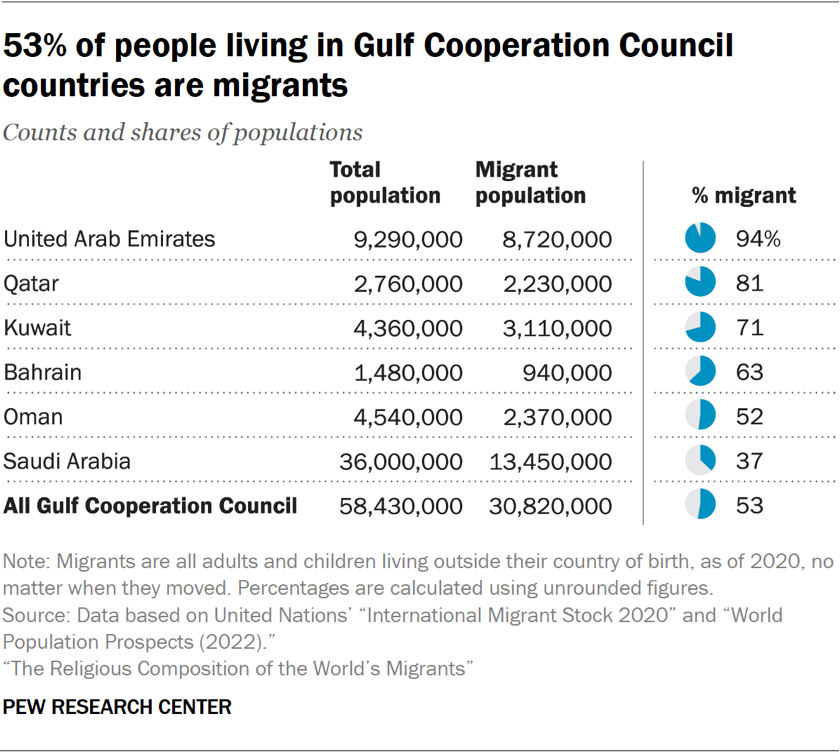
As of 2020, 53% of the 58 million people living in GCC countries are migrants.
Saudi Arabia, with a migrant share of 37%, is the only GCC country with a majority native-born population. On the other end of the scale, UAE’s population is 94% foreign born.
The GCC countries have thriving economies and strong demand for foreign labor, attracting migrant workers from South Asia and beyond. Many migrants return home after serving out contracts, and some later return to start new contracts. Under the UN’s definition, they are international migrants while they are living outside their country of birth, even if they are expected eventually to go back.
Data on the religious affiliation of migrants to GCC countries is generally not available, so we rely on indirect estimates. For example, we use information on the religious composition of Indian migrants to Egypt to estimate the religious mix of Indians in Gulf countries. (Refer to the Methodology for details.)
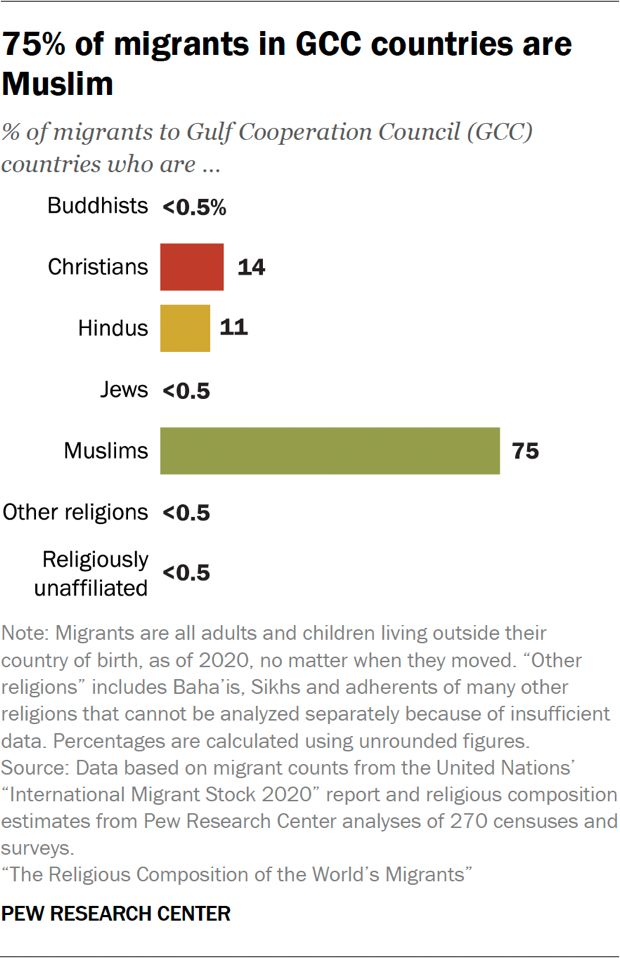
People born in GCC countries nearly always identify as Muslim in censuses and surveys. We estimate that most immigrants to these countries (75%) also are Muslim, while roughly 14% are Christian and 11% Hindu.
GCC governments closely conform to Islamic laws and norms. Pew Research Center studies consistently find that these countries have high levels of restrictions on religion.
Every GCC country has a law against blasphemy, and all but one (Bahrain) bans apostasy.
Religion is deeply entrenched and nonaffiliation is very rare in both GCC countries and common origin countries. We estimate that there are relatively few unaffiliated migrants in the region.
India is the top country of origin for migrants in GCC countries. Nearly one-third of the stock of migrants in GCC countries was born in India (9.9 million). Bangladesh is the second-leading origin country for GCC migrants (3.6 million), followed by Pakistan (3.5 million), Egypt (2.7 million) and Indonesia (2.4 million).
Most Hindu and Christian migrants to these countries are estimated to come from India. India is the top origin country for Muslim migrants as well, but many Muslims also come from other Asian countries or from countries in the Middle East or North Africa that are not in the GCC.
(Hindus make up about 80% of India’s population, while Christians constitute only 2%. Read “Spotlight on India” for details on the wide gap between the religious composition of those who have left India and those who remain.)
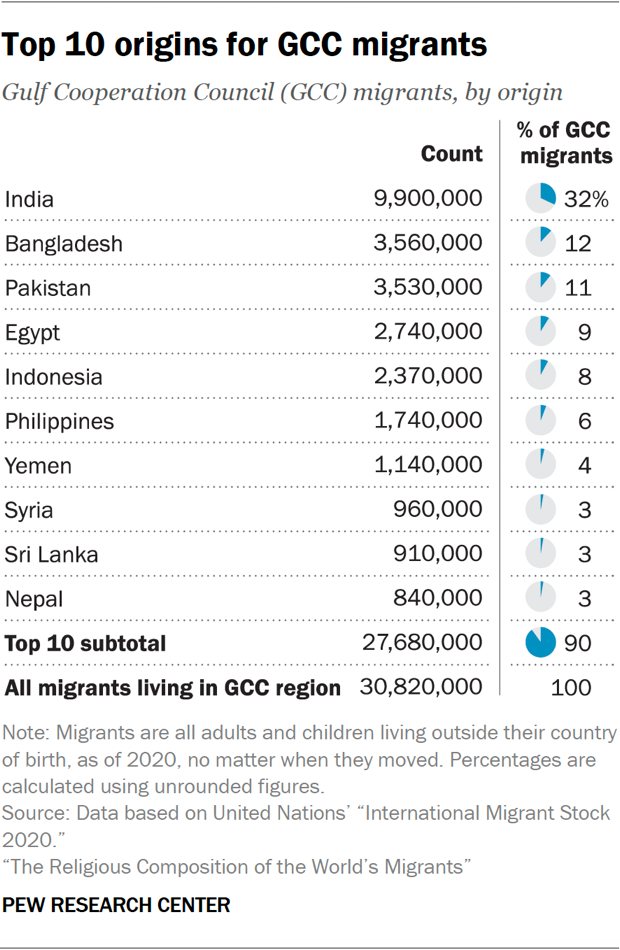
The migrant population in the GCC countries has increased from 8.2 million in 1990 to 30.8 million in 2020 (up 277%). This 22.7 million-person increase accounts for much of the area’s overall population growth. (The total population in these six countries rose from 22.3 million in 1990 to 58.4 million in 2020.)
While the share of migrants in GCC countries is exceptional, they are not the only countries in which population growth is primarily due to migration. Migration explains most population growth in many other places, particularly in countries with low fertility rates such as Greece, Germany and Portugal – all countries that would have seen their total populations shrink since 1990 if not for migration.
(Refer to the “Spotlight on Europe” section for more detail.)
Partly due to their relatively small native-born populations, GCC countries are not the source of many migrants. Fewer than a million migrants around the world come from this region.
Spotlight on India
India, which in 2023 overtook China to become the world’s most populous nation, was the top country of origin for migrants in 2020.
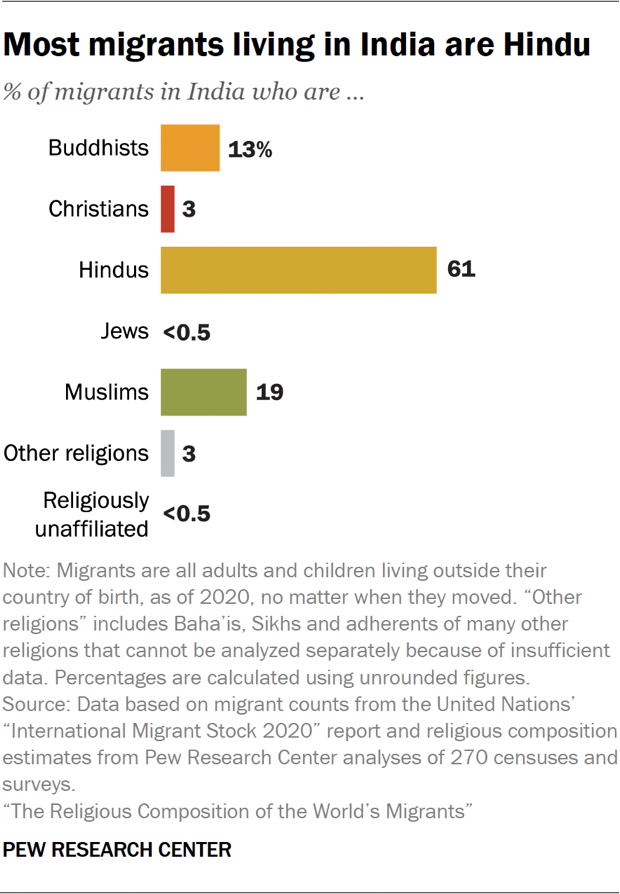
As a destination for migrants, however, India ranks 14th, after Turkey and Ukraine.
The number of migrants from India outnumbers migrants living in India by almost four-to-one.
India as a destination
In 2020, fewer than 5 million residents in India (or 0.4% of the total population) were born in another country.
This figure was down from 7.6 million in 1990, in part due to the aging and gradual deaths of migrants who moved to India from modern-day Pakistan and Bangladesh around the time of India’s Partition in 1947.
Neighboring Bangladesh and Pakistan continue to be the most common sources of foreign-born residents of India. About 2.6 million people in India were born in Bangladesh, and an additional 870,000 came from Pakistan. (These two countries were a single country after Partition and split up in 1971.)
Other top origins of migrants to India include Nepal (770,000), Sri Lanka (190,000) and China (110,000).
Between 1990 and 2020, the number of Bangladesh- and Pakistan-born migrants to India has declined, as some who moved during the Partition have died. Migrants from Nepal and China have increased in number.
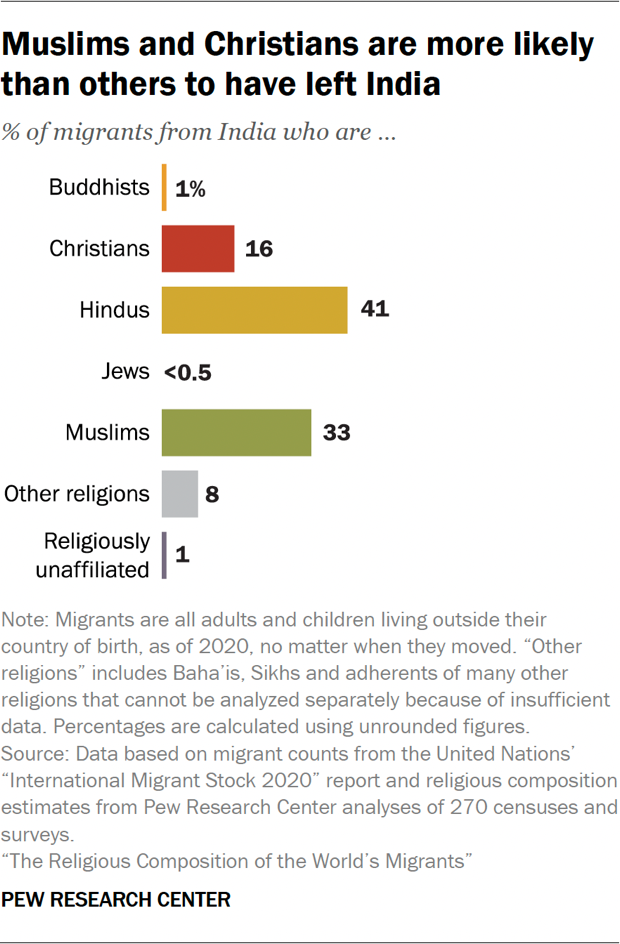
India’s population is overwhelmingly Hindu, with a sizable minority of Muslims. Migrants living in India are less likely than the general population to be Hindu (61% vs. 79%) and more likely to be Muslim (19% vs. 15%).
Migrants are about as likely as the native population to be Christian (3% vs. 2%). Buddhists, who tend to come from Bangladesh, Pakistan and China, make up a drastically larger share of immigrants (13%) than of the general population (less than 1%).
India as an origin
In 2020, an estimated 18.6 million India-born people were living elsewhere, almost three times as many as in 1990.28
Migrants from India most commonly live in the United Arab Emirates (3.6 million), followed by the United States (3 million), Saudi Arabia (2.6 million), Pakistan (1.6 million) and Oman (1.4 million).
(Read “Spotlight on the Gulf Cooperation Council countries” for more.)
The religious mix of migrants who have left India is very different from the religious composition of the country at large, as of 2020. Those who have left India are about half as likely to be Hindu as those who remain (41% vs. 79%). They are more than twice as likely as those who remain to be Muslim (33% vs. 15%), and about eight times as likely to be Christian (16% vs. 2%).
In recent decades, violent attacks on religious minorities, including Muslims and Christians, have been associated with a rising tide of Hindu nationalism in India.
Spotlight on the United States
The United States hosts more immigrants than any other country in the world.
How many U.S. immigrants are there?
According to the United Nations, the United States is home to about 50.6 million migrants, accounting for 15% of the overall U.S. population.
These figures are higher than the Pew Research Center estimates published earlier this year, which were based on U.S. Census Bureau data for 2022. Census data shows that the U.S. foreign-born population was 46.1 million in 2022, making up 13.8% of the overall population.
This discrepancy is largely due to differences in the way U.S. immigrants are defined.
The UN includes in its immigrant count anyone who was born outside the 50 U.S. states and the District of Columbia.
But U.S. sources generally do not consider people born in U.S. territories – nor people born in foreign countries to American parents – to be migrants, because they are U.S. citizens at birth.
For example, people born in Puerto Rico who now live in another part of the U.S. are counted as migrants by the UN but not by the U.S. Census Bureau.
The U.S. Census Bureau reports that the highest percentage of immigrants in the U.S. population recorded in any year since 1850 was 14.8%, in 1890.
However, due to its sheer size, the U.S. is not one of the countries with the highest percentages of immigrants in its population, according to our analysis of United Nations data. The U.S. ranks 68th on this list, below countries with smaller populations like Canada and Qatar.
Since 1990, the U.S. immigrant population has more than doubled, while the overall U.S. population has grown by around one-third.
Origins
Nearly 12 million U.S. migrants were born in Mexico, accounting for about a quarter of all immigrants in the U.S., according to our estimate based on adjusted UN data.
The next most common countries of origin are India (3 million), China (2.4 million) and the Philippines (2.2 million). An additional 2 million were born in the U.S. territory of Puerto Rico.29
All migrant counts include residents regardless of their legal status.
In recent decades, there has been increasing public debate about the large number of unauthorized migrants, many of whom enter along the U.S.-Mexico border. According to a previously published Pew Research Center analysis of U.S. Census Bureau data, unauthorized migrants accounted for about 3.3% of the overall U.S. population in 2022 and 23% of all foreign-born people living in the country.
Family reunification is the primary vehicle for legal immigration to the United States. Most authorized immigrants are admitted on the basis of family ties to U.S. citizens and green card holders.
Migration’s effect on secularization
Immigrants to the U.S. are more likely than the general population to have a religion.
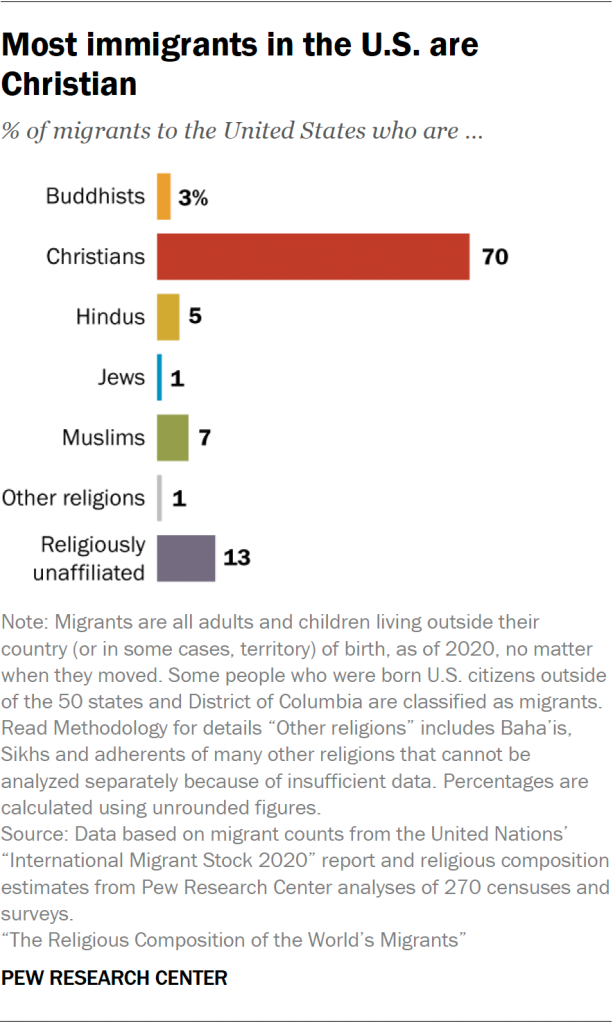
We estimate that 87% of migrants to the U.S. are religiously affiliated, including 70% who are Christian and more than one-in-ten who are either Muslim (7%), Hindu (5%) or Buddhist (3%). Jews and people from other religious groups make up the remaining 2%. Only 13% of migrants living in the U.S. are religiously unaffiliated.
In contrast, roughly 70% of the U.S. population is religiously affiliated as of 2020, including 64% who are Christian, 2% who are Jewish and about 1% each who are Buddhist, Hindu, Muslim or adherents of other religions. Roughly 30% of the U.S. population is religiously unaffiliated, identifying in our surveys as atheist, agnostic or nothing in particular.
The general U.S. population has been secularizing rapidly since 1990. Migration has partially offset the decline in the percentage of religiously affiliated people in the U.S. public, and it has contributed to rising percentages of some non-Christian religious groups, such as Muslims and Hindus. In other words, the shares of many U.S. religious groups are larger today than they would be if not for the arrival of new immigrants.
Migration out of the U.S. is not common. As of 2020, about 3 million people born in the U.S. were living in other countries. U.S.-born international migrants are mostly Christian (73%), with fewer who are religiously unaffiliated (15%), Jewish (5%), Muslim (3%) or adherents of other religions such as Hinduism and Buddhism. Mexico, Canada and the United Kingdom are the most common destinations for migrants who have left the U.S.




